|
Intellivision Games
Game Info & Reviews
Software
Mattel Electronics
Action
Arcade
ECS
Gaming
Intellivoice
Learning
Space
Sports
Strategy
1983
PlayCable
INTV Corporation
Blue Sky Rangers, Inc.
Imagic
Activision
Coleco
Parker Brothers
Atarisoft
Dextell, Ltd.
Interphase
Sega
Test
Demo
Independent
2600 Connection
5-11under
Blah Blah Woof Woof
CollectorVision
Côté Gamers
Dr. Ports
Elektronite
Freewheeling Games
Good Deal Games
Homebrew, Inc.
Intelligentvision
Intellivision Collector
Intellivision Revolution
Inty‑Home
Kai‑Magazine
Left Turn Only
Zbiciak Electronics
Intellivision, Inc.
Sears
Digiplay
CBS Electronics
Hardware
Mattel Electronics
INTV Corporation
Sears
Tandy
GTE Sylvania
Independent
Overlays
Text Table
Mattel Electronics
INTV Corporation
Imagic
Activision
Coleco
Dextell, Ltd.
Interphase
Intellivision, Inc.
Trade Lists
Want List
Other Stuff
Technical & Repair Info
Odds & Ends
Old Gaming Magazines
Site Updates
Contact INTV Funhouse
|

|
Talk about innovation! In 1981, Mattel finalized a deal to deliver Intellivision
games to homes across the nation via existing cable TV networks. Just call your
local cable provider and request PlayCable!
It just so happens that the company that developed the Intellivision chipset,
General Instrument (GI), also conveniently happened
to be involved in the cable industry already. Their Jerrold division, as far as
I can tell, is, to this day, still involved in producing cable converters. It
does appear that Motorola now owns GI, though. Jerrold's identity is less clear.
So, with such close ties to the cable industry already from the hardware side,
is it surprising that someone noticed that this would be a really cool idea? The
system worked by dedicating a channel that 'broadcast' the game data. A special
add-on peripheral, the PlayCable unit, could decode the game catalog (updated
monthly) and 'download' the games to the Master Component. The unit was designed to fit snugly against
the Master Component, and had the same burnished bronze and wood grain finish.
The Intellivision Library contains many useful images of PlayCable materials, including scans
of the entire user manual,
the flyer (also shown below),
and numerous images of the hardware.
|
 |
The Intellivision Gumbo
site has been kind enough to allow me to use the images of a PlayCable flyer
for this site. So, here it is! Note the prominence of the number 16 on the
back page. A rather humorous error here: a 16K microprocessor?
Hmm, perhaps they meant 16 bit? After all, the PlayCable itself
was limited in that it could only store games up to 4K in size. This was one
of the factors that led to its demise, according to the Intellivision
Productions folks.
| | | | | |
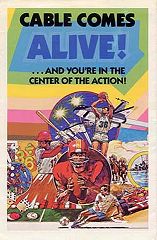
PlayCable Flyer: Front
|
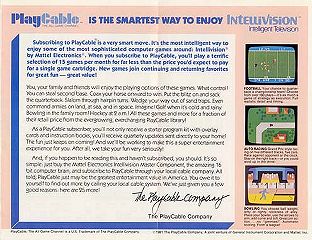
PlayCable Flyer: Center
|
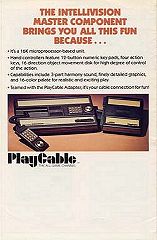
PlayCable Flyer: Back
|
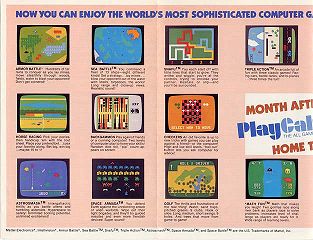
PlayCable Flyer: Games (left half)
|
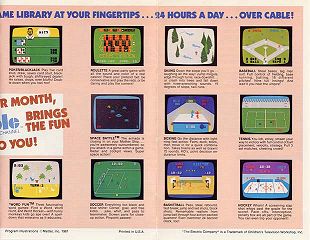
PlayCable Flyer: Games (right half)
|
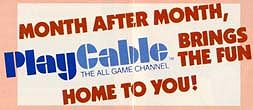 |
PlayCable Flyer
(images courtesy of the Intellivision Gumbo Website)
In addition to flyers, special versions of game manuals were also printed and
sent to customers. To store the manuals and, presumably, overlays, a box was
provided. It should be expected that some kind of service manual existed, and
possibly other documentation or packaging. Anyone who finds such materials and
is willing to share information or images, please
send a message!
PlayCable Unit with Master Component
As mentioned previously, the PlayCable unit was modeled after the original
Master Component in its appearance. It also has its own internal transformer to
step down 120V AC. I haven't probed the guts of my unit yet to see what voltages it
produces. Given the information from the BSRs, one can also conclude that there's a
ROM containing the program loader software as well as some kind a demodulator
used to decode the software data from the TV signal - similar in concept to
how our cable modems work today, but without the ability to upload data.
The Question of Packaging Variants
There are two images showing what the PlayCable unit's shell
looked like. Both the 'Jerrold' and 'General Instrument' units are known to exist. The Jerrold
version is also the unit pictured in an Electronic Games article.
The Blue Sky Rangers and the flyer shown above display the GI edition.
Is one more difficult to find than the other? (Is that like asking whether a hen's incisor is rarer than a hen's canine?)
Were the units packaged differently over the lifespan of the project, or in different regions
of the country? Anyone with any information
on the different units and logos please drop an
e-mail!
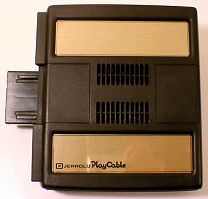
Jerrold and GI logo
Was this the standard logo?
(note the GI logo)
|
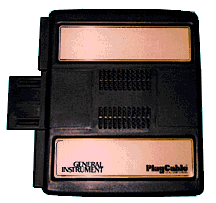
General Instrument logo
PlayCable logo variant
(image courtesy of the Blue Sky Rangers at
Intellivision Productions)
|
Someone had to do it... Oh, what could have been! If only I had the brown
ECS to have a consistent cosmetic appearance... Just imagine - add upload
capabilities to the PlayCable and you could use your ECS to load and share your
own programs across a network via the cassette player! Or, hook this up to the
real Keyboard Component and you've even got programmatic control over
the cassette! The 1149 could act as your server! Yeah!
On an unrelated note... It sure would have been cool to see the Intellivoice
and ECS released in the 2609 packaging style, as the PlayCable was. Now
that would look cool!
Someday, I hope to take some pictures of the guts and post them, too.
PlayCable Unit with Master Component, Intellivoice, and ECS
Not only was the PlayCable unit a nifty hardware device - it also contained
software act as the program loader. Here are a few questions and theories about just what that
software might have done. I hope someone out there can answer them...
- How did game selection really work? My Theory (ALL conjecture):
- Upon power-on or hardware reset, PlayCable game loader loads and receives catalog
- After receiving catalog, game loader waits for user to select title
- After title selected, game loader waits for game to download, storing it in its 4K RAM buffer
- After download complete, a flag is set (somewhere) that game has successfully downloaded
- Game loader executes a 'soft' reset
- Game loader program loads; after a soft reset, the 'game ready' flag causes
the program to jump to the memory location storing the game, and that's what
the Intellivision sees as the running program
This little theory is probably rife with errors, but I think conceptually, something
like this is what's going on. One thing that's not clear is whether games that
bypassed the EXEC would work.
- If someone had made a videotape of the PlayCable channel using a VCR, would
it have successfully captured the entire signal? If so, could you then play back
said tape through a VCR today and get the game?
- What were all of the games ever made available on PlayCable? We do know that
they all were 4K games.
- What kind of hardware did the cable provider need to 'broadcast' the games?
- How were new sets of games delivered to the cable provider?
Since the PlayCable channel has long since bit the dust, we can't get nice
screen shots of what the game selection software looks like. (Is there a nifty
emu project there?) Here are some screen shots of what you get with a PlayCable
unit today. I did not hook the unit up to my cable line. As is the case with the System
Changer, you get a default screen if the service isn't available.
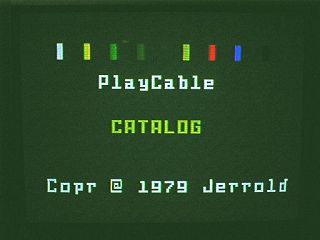
This image was created by just taking a picture of the screen with a digital
camera. The background color is due to low light conditions, a low-end camera,
and inexperience in photography.
|
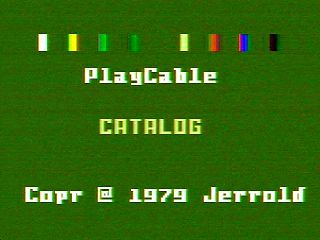
This image was created using an ATI TV Wonder VE board.
|
|